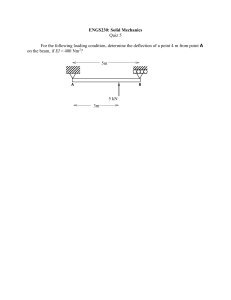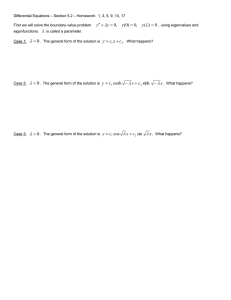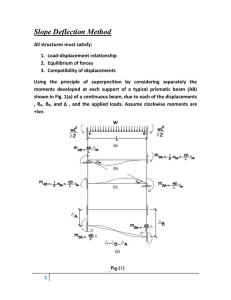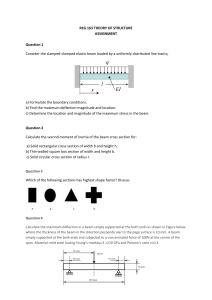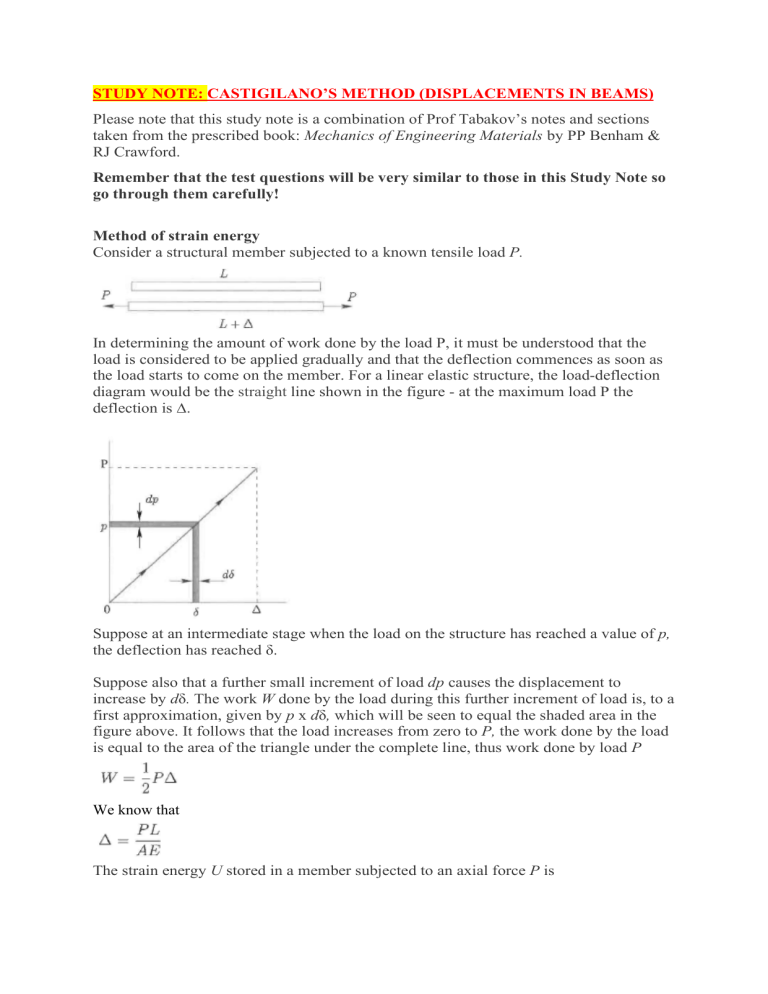
STUDY NOTE: CASTIGILANO’S METHOD (DISPLACEMENTS IN BEAMS) Please note that this study note is a combination of Prof Tabakov’s notes and sections taken from the prescribed book: Mechanics of Engineering Materials by PP Benham & RJ Crawford. Remember that the test questions will be very similar to those in this Study Note so go through them carefully! Method of strain energy Consider a structural member subjected to a known tensile load P. In determining the amount of work done by the load P, it must be understood that the load is considered to be applied gradually and that the deflection commences as soon as the load starts to come on the member. For a linear elastic structure, the load-deflection diagram would be the straight line shown in the figure - at the maximum load P the deflection is ∆. Suppose at an intermediate stage when the load on the structure has reached a value of p, the deflection has reached δ. Suppose also that a further small increment of load dp causes the displacement to increase by dδ. The work W done by the load during this further increment of load is, to a first approximation, given by p x dδ, which will be seen to equal the shaded area in the figure above. It follows that the load increases from zero to P, the work done by the load is equal to the area of the triangle under the complete line, thus work done by load P We know that The strain energy U stored in a member subjected to an axial force P is and it is clearly irrelevant whether P is a positive or negative value. Displacements using the method of strain energy If a moment M moves through a small angle dθ, the moment remaining constant during this rotation, the work done by the moment is Md0. If a moment increases gradually from zero to M and during this application a total rotation of θ occurs, the rotation at any stage being proportional to the applied moment. The work done on this section by the bending moment (internal forces) is The following ratio is valid here Thus, we can write Substituting it into expression for the work done, we arrive at The work done for the entire beam can be obtained by integration of this expression. Obviously, the work done equals to the accumulated strain energy. Thus, the strain energy stored in the element: Often, both E and I are constant along the length of the beam and the expression would become: By expressing the strain energy U in terms of the independent displacements ∆i it can be shown that that a partial derivative with respect to any of the displacements is equal to the force P acting in the direction of this displacement: The deflection ∆ is thus This may also be expressed as 1 𝐿𝐿 𝛿𝛿𝛿𝛿 ∆= � (𝑀𝑀)( )𝑑𝑑𝑑𝑑 𝐸𝐸𝐸𝐸 0 𝛿𝛿𝛿𝛿 for deflection under the load. This is known as the modified Castigliano’s theorem. The first example below is solved using the strain energy formula but all the rest are solved using the modified theorem (because its slightly easier because calculating M2 is 𝛿𝛿𝛿𝛿 usually more difficult than calculating (𝑀𝑀)( 𝛿𝛿𝛿𝛿 ). Example 1: Find the deflection at the point of the application of the concentrated load P for the cantilever below. Solution: The bending moment at a distance x from the end of the beam is M = Px Thus This is a standard solution. Example 2: Determine the displacement at the mid-span of a simply supported beam with a uniformly distributed load (UDL) of q. Solution: At any distance x from the left-hand side the bending moment is M = qx/2(L-x), or To calculate the displacement at midspan, we apply an imaginary concentrated load P at this point. Then and Thus using the modified theorem, the deflection ∆ is (see red box above) We must put P = 0 to obtain the deflection at midspan: If we require the deflection due to the point load only, we put q = 0, then Example 3: A simply-supported beam carries a concentrated load P at a distance a from the left-hand support. Determine the deflection of the beam directly underneath the load. Solution: We have The support reactions are The bending moment for the section of the beam to the LHS of P is: 𝑃𝑃𝑃𝑃 ML = 𝐿𝐿 x The bending moment for the section of the beam to the RHS of P is: 𝑃𝑃𝑃𝑃 ML = 𝐿𝐿 x Thus, On LHS: 1 𝑎𝑎 𝑃𝑃𝑃𝑃 𝑏𝑏 1 𝑎𝑎 𝑃𝑃𝑃𝑃2 𝑎𝑎 1 𝑏𝑏 𝑃𝑃𝑃𝑃2 ∆ = 𝐸𝐸𝐸𝐸 ∫0 ( 𝐿𝐿 𝑥𝑥)(𝐿𝐿 𝑥𝑥)𝑑𝑑𝑑𝑑 = 𝐸𝐸𝐸𝐸 ∫0 𝐿𝐿2 𝑥𝑥 2 𝑑𝑑𝑑𝑑 = 𝑃𝑃𝑏𝑏2 𝑎𝑎3 3𝐸𝐸𝐸𝐸𝐿𝐿2 On RHS: 1 𝑏𝑏 𝑃𝑃𝑃𝑃 ∆ = 𝐸𝐸𝐸𝐸 ∫0 ( 𝐿𝐿 𝑥𝑥)(𝐿𝐿 𝑥𝑥)𝑑𝑑𝑑𝑑 = 𝐸𝐸𝐸𝐸 ∫0 𝐿𝐿2 𝑥𝑥 2 𝑑𝑑𝑑𝑑 = 𝑃𝑃𝑎𝑎2 𝑏𝑏3 3𝐸𝐸𝐸𝐸𝐿𝐿2 Add these deflections together and rationalise: ∆= 𝑃𝑃𝑏𝑏2 𝑎𝑎3 3𝐸𝐸𝐸𝐸𝐿𝐿2 + 𝑃𝑃𝑎𝑎2 𝑏𝑏3 3𝐸𝐸𝐸𝐸𝐿𝐿2 = 𝑃𝑃𝑏𝑏2 𝑎𝑎2 3𝐸𝐸𝐸𝐸𝐿𝐿2 𝑃𝑃𝑎𝑎2 (𝑎𝑎 + 𝑏𝑏) = 3𝐸𝐸𝐸𝐸𝐸𝐸 (𝐿𝐿 − 𝑎𝑎)2 = 𝑃𝑃𝑎𝑎2 𝑏𝑏2 3𝐸𝐸𝐸𝐸𝐸𝐸 Example 4: A simple beam AB supports a uniform load of intensity q and a concentrated load P, as shown below. The load P acts at the midpoint C of the beam. Determine the downward deflection at the midpoint of the beam. Solution: Once again, as in example 2, because the beam and its loading are symmetrical about the midpoint, the strain energy for the entire beam is equal to twice the strain energy for the left-hand half of the beam. Therefore, we need to analyse only the left-hand half of the beam. The reaction at the left-hand support is The bending moment is Then 𝛿𝛿𝛿𝛿 𝛿𝛿𝛿𝛿 = x/2 and 1 𝐿𝐿/2 𝑥𝑥 ∆= � (𝑀𝑀)( )𝑑𝑑𝑑𝑑 𝐸𝐸𝐸𝐸 0 2 This answer makes perfect sense as it is the same for example 2 above (when P ≠ 0 in that example). Example 5. A simple beam with an overhang supports a uniform load of intensity q on span AB and a concentrated load P at end C of the overhang. Determine the deflection δ at C. Solution: The reaction at support A is Taking moments for span AB: where xi is measured from support A. The bending moment in the overhang is where x2 is measured from support C. The partial derivates 𝛿𝛿𝛿𝛿/𝛿𝛿𝛿𝛿 are: Using the modified theorem By substitution we get: After performing the integrations and combining terms we get Example 6. An overhanging beam ABC supports a concentrated load P at the end of the overhang. Span AB has length L and the overhang has length a. Determine the deflection δC at the end of the overhang. Solution: The reaction at support A is Taking moments about B, the moment to the left is: ML = − 𝑃𝑃𝑃𝑃 𝐿𝐿 x And to the right of B: MR = -Px Thus, on LHS 1 𝐿𝐿 𝑃𝑃𝑃𝑃 1 𝑎𝑎 𝑎𝑎 1 𝐿𝐿 𝑃𝑃𝑃𝑃2 ∆ = 𝐸𝐸𝐸𝐸 ∫0 ( 𝐿𝐿 𝑥𝑥)(𝐿𝐿 𝑥𝑥)𝑑𝑑𝑑𝑑 = 𝐸𝐸𝐸𝐸 ∫0 On RHS 1 𝐿𝐿2 𝑎𝑎 𝑥𝑥 2 𝑑𝑑𝑑𝑑 = ∆ = 𝐸𝐸𝐸𝐸 ∫0 (𝑃𝑃𝑃𝑃)(𝑥𝑥)𝑑𝑑𝑑𝑑 = 𝐸𝐸𝐸𝐸 ∫0 𝑃𝑃𝑥𝑥 2 𝑑𝑑𝑑𝑑 = 𝑃𝑃𝑎𝑎2 𝐿𝐿 3𝐸𝐸𝐸𝐸 𝑃𝑃𝑎𝑎3 3𝐸𝐸𝐸𝐸 Adding the two deflections together and rationalising ∆= 𝑃𝑃𝑎𝑎3 𝐿𝐿 3𝐸𝐸𝐸𝐸 𝑃𝑃𝑎𝑎3 + 3𝐸𝐸𝐸𝐸 = 𝑃𝑃𝑎𝑎2 3𝐸𝐸𝐸𝐸 (𝐿𝐿 + 𝑎𝑎) Example 7. The cantilever beam shown supports a triangularly distributed load of maximum intensity q0. Determine the deflection of the beam at the free end. Solution: As in Example 2 we must add an imaginary load P at the free end B of the cantilever, as that is where we need to determine the deflection. Thus: Taking moments about A we get 𝑀𝑀 = 𝑃𝑃𝑃𝑃 + 𝑞𝑞𝑥𝑥 3 6𝐿𝐿 𝑞𝑞𝑥𝑥3 (or 𝑀𝑀 = −𝑃𝑃𝑃𝑃 − 6𝐿𝐿 depending on what you regard as the positive direction) Thus, 1 𝐿𝐿 ∆ = 𝐸𝐸𝐸𝐸 ∫0 (𝑃𝑃𝑃𝑃 + 𝑞𝑞𝑥𝑥 3 1 𝐿𝐿 )(𝑥𝑥)𝑑𝑑𝑑𝑑 = 𝐸𝐸𝐸𝐸 ∫0 (𝑃𝑃𝑥𝑥 2 + 6𝐿𝐿 𝑞𝑞𝑥𝑥 4 Now, setting P = 0, we get the deflection at B as ∆= 𝑞𝑞𝐿𝐿4 30𝐸𝐸𝐸𝐸 𝑃𝑃𝐿𝐿3 𝑞𝑞𝐿𝐿4 )𝑑𝑑𝑑𝑑 = 3𝐸𝐸𝐸𝐸 + 30𝐸𝐸𝐸𝐸 6𝐿𝐿
